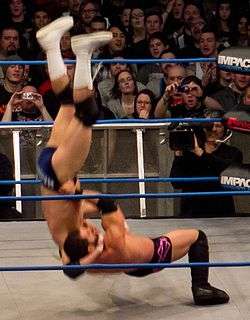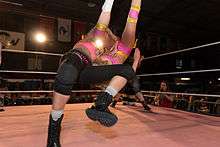Brainbuster
A brainbuster is a professional wrestling throw in which a wrestler puts the opponent in a front facelock, hooks their pants or thigh, and lifts them up as if they were executing a vertical suplex. The wrestler then falls onto their back so that the opponent lands on their head while remaining vertical. This move is a version of the DDT. It was innovated by Killer Karl Kox. In Japanese puroresu, the term "brainbuster" refers to a regular vertical suplex, while the move elsewhere known as a brainbuster is referred to as a "vertical drop brainbuster".[1] The brainbuster is banned in WWE because the person receiving the move will land on the top of their head or neck without protection. The botched executions of the belly-to-belly piledriver by Owen Hart and The Undertaker led to changes in the wrestling style of two comparable wrestlers[2], specifically Stone Cold Steve Austin and Goldberg, respectively, with the former changing from a technician to a brawler and the latter introducting an alternative to his Jackhammer finisher by debuting a brainbuster at the Super ShowDown of 2019 in Saudi Arabia.

Variants
Cradle brainbuster
Also known as a belly-to-belly brainbuster, the wrestler stands facing a standing opponent and then wraps both arms around the opponent's torso, lifting them off the ground. The wrestler then shifts their grip so they are holding the opponent by their legs, gripping the opponent behind the knee. The wrestler then removes one arm from the opponent’s leg and quickly applies a front facelock with that arm, lifts the opponent as if they were using a vertical suplex and lands the opponent on the back of their head.
Double underhook brainbuster
Also known as the Michinoku Driver (not to be confused with another move with a similar name) and a butterfly brainbuster, this move sees a wrestler first face an opponent and apply a double underhook before then lifting the opponent upside down and falling backwards down to the mat onto his back, driving the opponent head first down to the mat.

Fisherman buster
A fisherman buster is a variation of the brainbuster in which the wrestler will hook the opponent's leg to aid in lifting them off the ground.[3] With the opponent elevated, the wrestler will perform a fisherman suplex, driving the head of the opponent into the ground.Mercedes Martinez uses this as her Finisher [3]
Cross-legged fisherman buster
This variation in a wrestler puts his/her opponent in a front facelock and uses his/her free arm to go under the opponent's near leg and hook the far one. After lifting him/her off the ground, the wrestler then jumps up and falls down on his/her back, slamming his/her opponent down to the mat head first.
Small package driver
A variation of the fisherman buster,[4] in this version the wrestler traps the opponent's free leg between their own legs when delivering the move, resulting in a small package.[4] This was used by Tyler Black, calling it God's Last Gift.
Wrist-clutch fisherman buster
This variation involves grabbing and pulling by the opponent's wrist then lifting them up into the air before falling to their back, slamming the opponent to the ground on the back of their head/neck.
Inverted brainbuster
The wrestler begins behind and facing a standing opponent. The wrestler then pulls the head of the opponent back and applies an inverted facelock to the opponent with one arm. The wrestler then places his/her other arm under the lower back of the opponent, then uses that arm to elevate the opponent until they are vertical. The wrestler then jumps up and falls down on his/her back, driving the head of the opponent to the mat.
Jumping brainbuster
Also known as a spike brainbuster. Instead of just falling down onto his/her own back, the attacking wrestler jumps up and uses his momentum to drive the opponent down onto the top of their head.
Delayed brainbuster
Also known as the Ghost Buster, this is a variation of the standard brainbuster in which the executing wrestler holds their opponent in a vertical suplex position for up to 10 seconds before completing the maneuver.
Northern Lights buster
A Northern Lights buster is a variation of the brainbuster in which the wrestler will lift the opponent as if they were using a Northern Lights suplex and lands the opponent on the back of their head.
Scoop brainbuster
Also known as the Northern Lights Bomb in Japan. This move sees the wrestler put the opponent in a front facelock, scoop one of the opponents thighs with his free hand, lift him or her upside down, and then drop to his side or back, driving the opponent to the mat on his neck and shoulders, or on the top of his head.
Single underhook brainbuster
This variation is performed when a wrestler faces his/her opponent and hooks one of their arms before lifting the opponent upside down, then falling backwards to the mat onto their back, driving the opponent down on their head.It's used by Finn Bálor as the 1916.
Twisting brainbuster
Also known as a revolution brainbuster, this brainbuster is performed when the wrestler delivering the maneuver twists his body while holding the opponent in the upwards position, usually dropping their opponent during the rotation
See also
References
- バーティカルスープレックス. Pro Wrestling Info Net (in Japanese). Retrieved September 18, 2013.
- Campbell, Brian (April 23, 2018). "Bill Goldberg explains how, why WWE should consider giving Hulk Hogan a second chance". CBSSports.com. Retrieved March 10, 2020.
- "Fantasy Warefare: The Fabulous Moolah vs. Jazz". 9 (10). Raw Magazine. October 2003. Cite journal requires
|journal=(help) Copy available at Archived 2008-11-21 at the Wayback Machine - "ROH 遠征初日、Kushidaが衝撃の"新技"でジェイ・リーサルを撃破!メインでケニー&ヤングバックスが大暴れ!【5.7トロント大会結果】". New Japan Pro-Wrestling (in Japanese). May 11, 2017. Retrieved May 22, 2017.